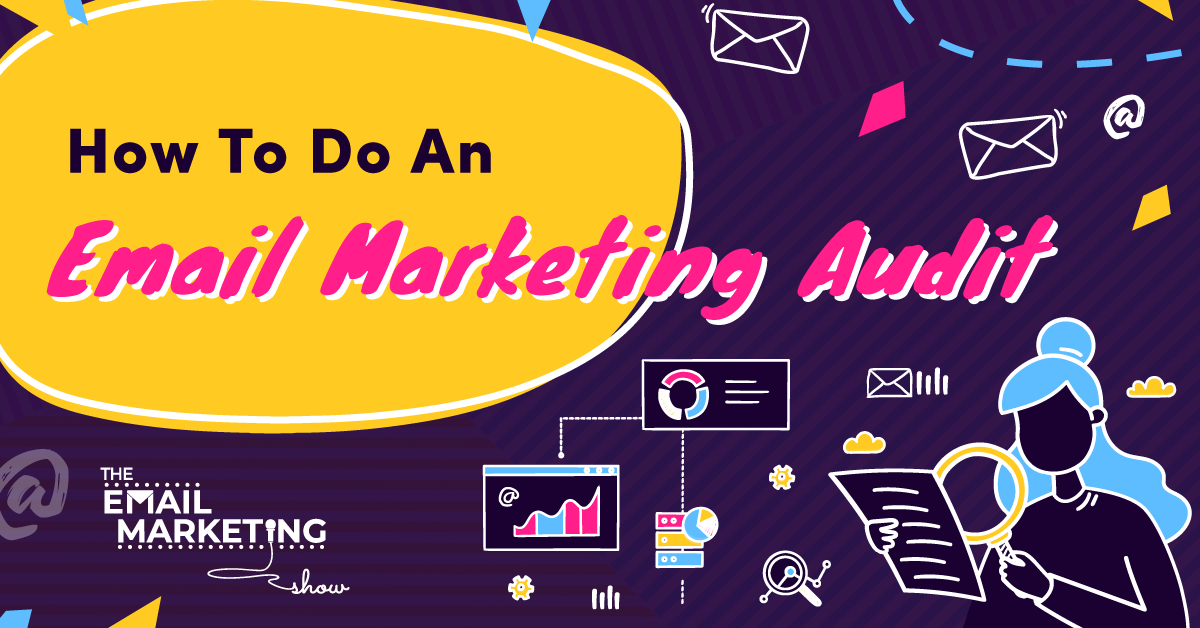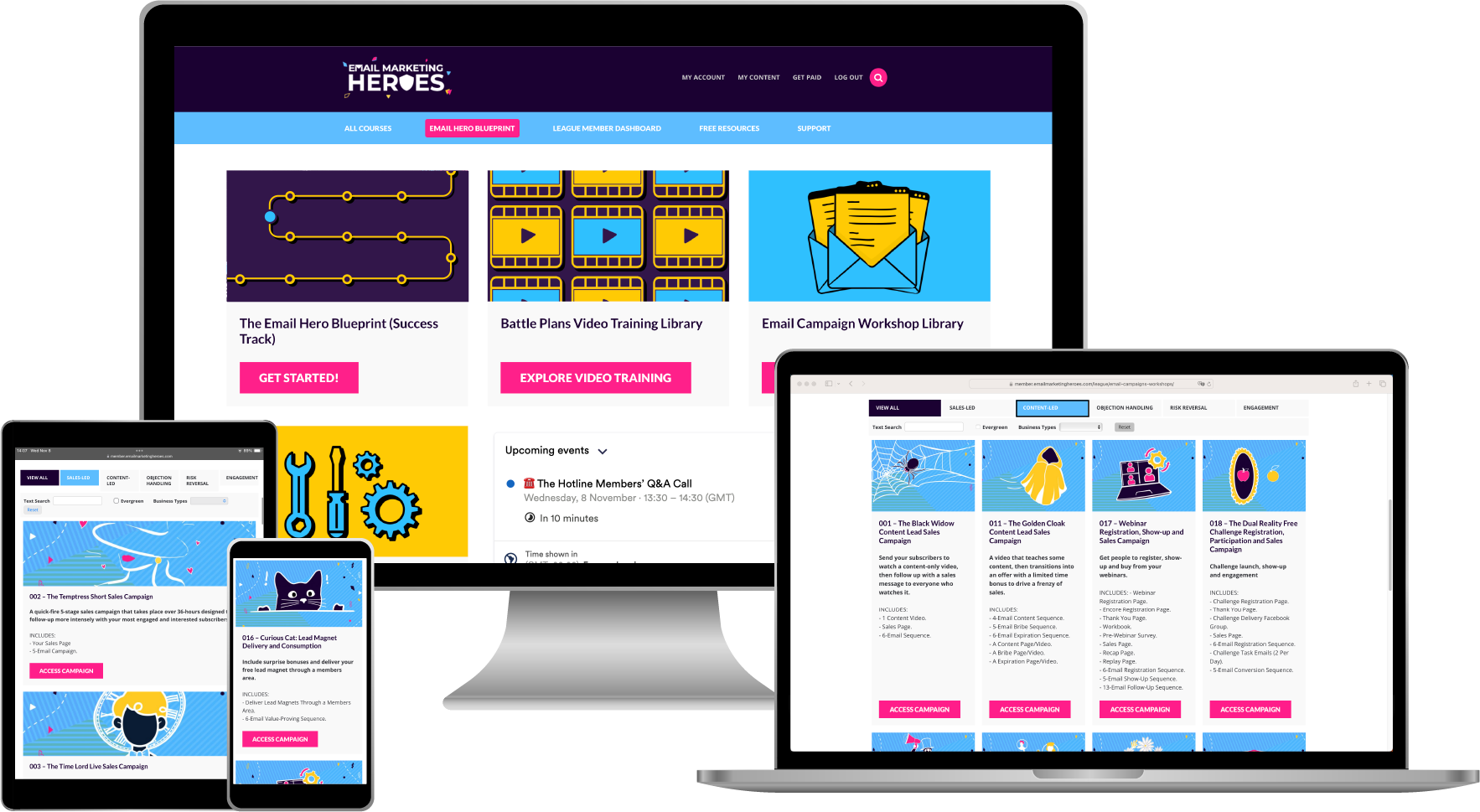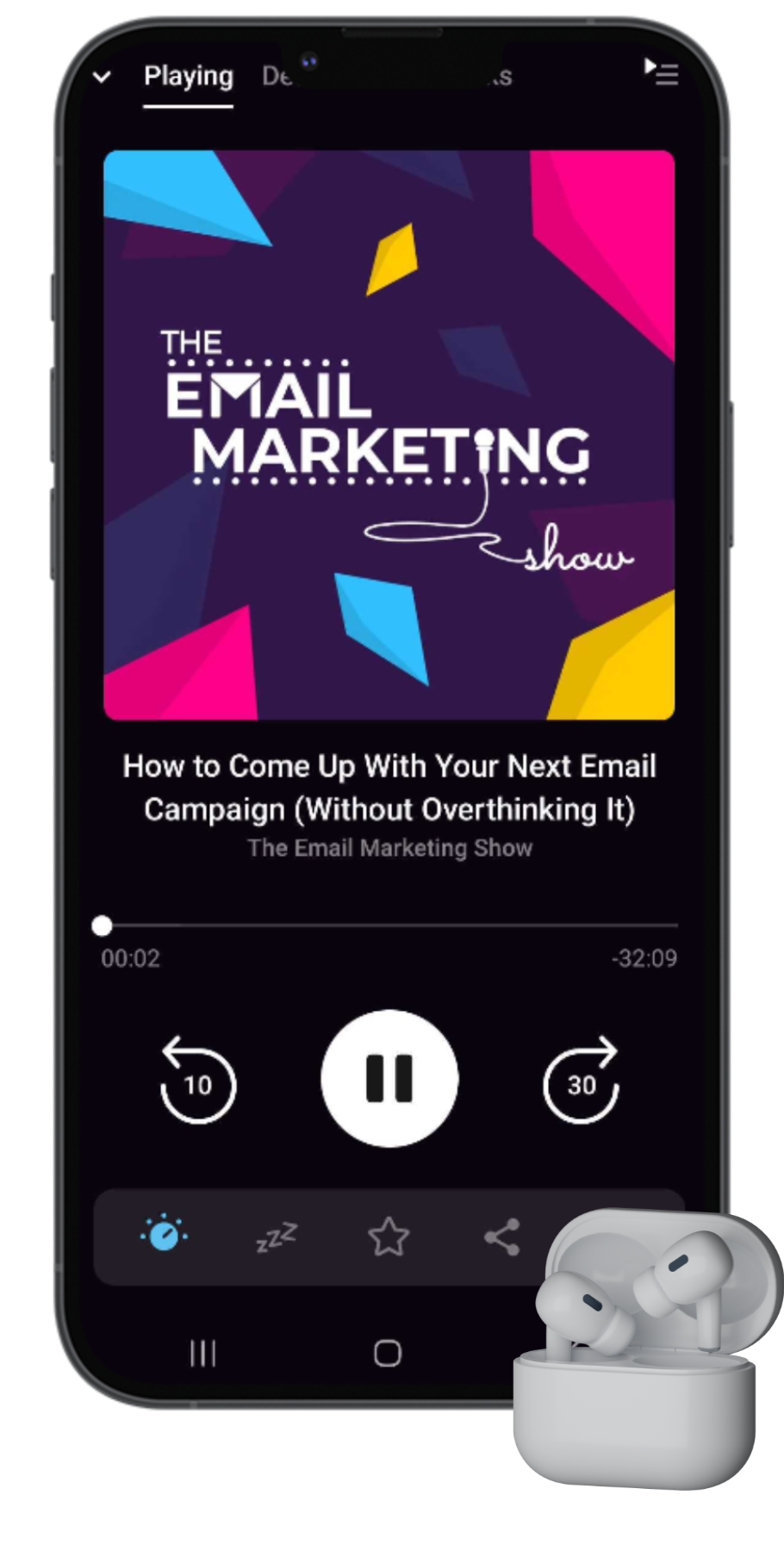
How To Audit Your Email Marketing
Have you ever done an email marketing audit? Want to find out what to check and what data to collect to improve your email marketing? Because (spoiler alert) what you think you should be doing is probably not what is going to move the needle the most for you!
Ready to take some notes?
SOME EPISODE HIGHLIGHTS: (0:09) Want to make your sales from your email marketing? Grab our Click Tricks. (5:03) Create a baseline. (7:08) Find out how many subscribers you're gaining and losing every month. (8:21) Find out where your subscribers are coming from. (10:29) Work out your cost per subscriber and how long it takes you to earn that cost back. (14:06) Calculate how much you earn per subscriber and your EPSPM. (17:11) Calculate the highest and the average order value per customer. (21:25) When's the last time you emailed your list and how often do you make an offer? (26:57) Are people engaging with your emails and what do you do with those who aren't? (29:24) Subject line of the week.
Want to get more sales from your email marketing?
We put a little something together for you. It's really cool and it's FREE (yes, it's cool and free – we're nice like that). If you want to make more sales from your email marketing, you need more clicks on the things that you're selling!
That's why we're giving you 12 creative ways to help you get more clicks in every email you send. It's a FREE download, and it's called Click Tricks. You can grab it here.
Create a baseline
When we used to do consulting and help people with their email marketing, the first thing we'd do would be to find out the state of play. If you don’t know how you’re currently doing, you don’t know where your biggest opportunities for improvement are. You may feel, instinctively, that you need to improve in a certain area. But after looking into the data you might find that something else needs your attention first.
For example, if you’re not converting through your email marketing, it doesn’t matter how many people you bring in at the front end. It's like you're showing them an empty shop floor where they can't buy anything.
So the first thing you want to look at is how many subscribers you have on your list. It doesn't matter what the number is, as long as you know what it is. That gives you your baseline.
Find out how many subscribers you’re gaining or losing every month
The next bit of data you need to find is how many subscribers you're bringing in every month. And then you want to compare that number with the people who unsubscribe in the same period.
We track all this in a spreadsheet that acts as our business dashboard. On the first day of every month, we capture this information for the previous month. And over time, this gives you a general sense of list growth.
However, don't just assume that your list will grow at the same pace every single month forever – not unless you've done the rest of the analysis. Of course, you want to increase the number of people who join your list and decrease your unsubscribes every month. But if you think that all your problems will be over if you bring in more subscribers every month, that's probably not the case because there are many other factors at play.
Find out where your subscribers are coming from
The next thing you want to check is where your subscribers are coming from. For example, the majority of people join our list from Instagram, our free Facebook group, our lead magnets, and our paid traffic. So work out what your channels are and figure out how many subscribers join you every month from each of those channels.
This is so important that we put together a resource and a piece of training inside our membership The League, so if you’re in there, check it out. You don’t want to rely on external data on this because it’s not accurate. It's all about knowing specifically which subscribers come from which platform because that tells you what's working and what isn't.
And once you know this, you can do more of what works and stop doing what isn't. For example, we stopped investing so much time and energy into Twitter because the number of subscribers coming into our world and turning into customers from this channel was very low. So we're focusing on what works for us instead.
Work out your cost per subscriber and how long it takes you to earn that cost back
Now that you have that data, you can start looking at the economics of it. And the first thing to find out is how much it costs you to get a new subscriber. In some cases, that cost is going to be measured in time. For example, if you’re posting content on Instagram and not sending ads to it, it's organic growth. You're spending time but not money on it.
However, if you have a social media manager or run paid ads to your content, then you need to work out your monthly spending and divide it by the number of subscribers you gain every month from that channel. That tells you what your cost per subscriber is.
Once you know how much it's costing you to acquire every subscriber, you also want to know how long it takes you, on average, to get that money back. So if it’s costing you $8 to acquire a subscriber from your lead magnet, for example, you can hopefully make some of that money back by sending some paid offers to that subscriber via your email marketing. But realistically, it'll take you some time to recover it.
Knowing exactly how long is important because ultimately list growth is only sustainable if you're able to make your money back fairly quickly through your email marketing. Despite what a lot of people might think or say, marketing is a numbers game, so we need to stop making decisions based on anything other than numbers. Because unless we calculate them wrong, numbers don't lie to us!
Calculate how much you earn per subscriber and your EPSPM
The next metric is to look at how much you earn on average per subscriber in the first 14, 30, or 60 days. You do this by looking at how many subscribers you bring in a set period of time and how much they spend with you in that same period. Knowing this tells you how much you can afford to spend to acquire a new subscriber – now you know how long it takes for a subscriber to become profitable for you.
Out of these, the most important metric is the one that relates to the first 14-30 days because that’s when you’re looking at breaking even or making a small profit. If you don’t know these numbers, and you’re running ads, for example, it means you’re doing it blindly, and you're just waiting to lose money!
Also, the reason why we want to know how much a subscriber is worth to us in the first 60 days is that generally speaking, during that time we put them through automated campaigns in our email engine to maximise the value per subscriber and to get our money back.
After that period of time, subscribers come out of our email engine and start receiving our daily emails, so we look at a different metric. That's the EPSPM or Earnings Per Subscriber Per Month. And this is important because it tells us where we have opportunities to make more out of our list.

The Top 10 Books To 'Power Up' Your Email Marketing
10 book recommendations that will improve all areas of your email marketing (including some underground treasures that we stumbled upon which have been game-changing for us).
Calculate the highest and the average order value per customer
The next metric you want to calculate is to do with your customers – that's subscribers who have made a purchase with you. You want to look at two numbers:
- The highest possible order value.
- And the average order value.
The highest order value looks at the maximum someone can spend with you. If you only sell a book for $7 and nothing else, for example, that's all your customers can buy. There's no upsell, which means you're putting yourself at a disadvantage. But if you have additional offers, people can potentially spend more with you.
And if your highest order value is $1,000, for example, you then want to look at how much people spend on average with you. So if you make 100 sales in one month, for example, how much was the average spend? And how does that compare with the highest order value? This is important because it helps you make an informed decision on how much you can spend on your advertising budget, for example, without putting yourself at risk.
Have you proven your offer?
Another thing you want to look at is whether you've proven your offer. We're not talking about the product here – it's the way it's packaged, positioned, priced, and set up. It's about the sales mechanism, which includes the sales page, sales videos, your webinars, the email sequence that goes with it, etc. Have you proven that those things work so that if you run traffic to that offer or run an email campaign around it, you know it's going to perform?
Of course, that doesn’t mean that something that works now is going to work forever. But if it's working, you'll know because the conversion rate of those mechanisms will ensure that your average order value is as close as possible to your highest order value. For example, if your highest possible order value is $1,000 but your average order value is $10, your conversion mechanism isn't currently working – people are not buying the upsell. So you need to work on that.
When’s the last time you emailed your list and how often do you make an offer?
The next thing you want to look at is when you emailed your list last and how often you send emails. This is important because it determines the reputation of your emails. If you email regularly, Gmail and the other email platforms of this world will class you as someone who keeps in touch with people. Your emails will be deemed reputable, and you will go into someone's Primary folder. If not, those platforms will start being cautious about your emails.
But also, you want to look at how often you make an offer to your subscribers to buy something. You may be someone who emails often and gives a lot of value, but if you're not making offers (or not making them very often) people don’t have the opportunity to buy from you. And if you think that when someone's ready to buy, they'll suddenly remember you, that's not how it works. Because unless you're present in people's inboxes, they will forget that your product even exists.
So you need to make offers and constantly remind people of what you do. Otherwise, they can't buy your product. And on top of that, you need to dress your product in different ways – with offers that make it appealing to different people in different ways.
And this isn't just for your subscribers – it's for your customers as well. How often are you making offers to the people who've already bought from you? If you have a membership, for example, it means you have people who have proven that they value what you teach. So go back to them – they're your best customers. And think of ways to help them more and resell to them.
We all obsess about selling to someone for the first time, but that's the hardest thing to do. Making the first sale to subscribers is the hardest piece of the puzzle. It's much easier to re-sell to someone who's already bought from you. That's why we have so many campaigns inside The League that help you do that by using lots of psychological angles.
Are people engaging with your emails and what do you do with those who aren't?
The final piece of the puzzle is to understand how many people are engaging with your emails in a 14, 30, or 60-day period. If not enough people engage with your emails in that period of time, a quick fix is to email more often. That's going to boost your engagement.
But also, what are you doing with the people who disengage? Will you run our LOL, revival campaign to see if they're still interested, for example? Are you going to delete them? What you do here is important because you want to keep your deliverability and engagement high. The vast majority of what makes emails deliverable is your engagement with your list so make sure people are taking notice of your emails and engaging with them.
Would you like to work with our Agency?
These are the questions we used to ask our coaching clients and that we always ask our agency clients. We have skilled professionals who write your emails for you if you're someone who doesn't have time to work on customising campaigns and templates for yourself.
If you'd like to speak to someone about writing your emails for you so you can turn your subscribers into customers (and then repeat customers) without having to do the work, let’s have a chat. You can apply to work with us and see if we're a good fit for you. Here’s the link for you to check.
Subject line of the week
This week’s subject line is “My first is in Goldfish” as if it was a riddle. The hook of this relates to a practice we talked about before. And that's to take a standard thing that people recognise and use it in an interesting way.
Rob also added the emoji of a fish to this subject line. And that was to make it pop in the raft of subject lines in someone's inbox. Not many people are using emojis in subject lines at the moment. So it’s a good way to make your emails stand out.
Useful Episode Resources
Related episodes
Why We Started an Email Marketing Agency.
The Surprising Thing That REALLY Impacts Your Email Deliverability.
What to do if you have a high unsubscribe rate.
FREE list of the top 10 books to improve your email marketing
If you want to write better emails, come up with better content, and move your readers to click and buy, here's how. We put together this list of our Top 10 most highly recommended books that will improve all areas of your email marketing (including some underground treasures that we happened upon, which have been game-changing for us). Grab your FREE list here.
Join our FREE Facebook group
If you want to chat about how you can maximise the value of your email list and make more money from every subscriber, we can help! We know your business is different, so come and hang out in our FREE Facebook group, the Email Marketing Show Community for Course Creators and Coaches. We share a lot of training and resources, and you can talk about what you're up to.
Try ResponseSuite for $1
This week's episode is sponsored by ResponseSuite.com, the survey quiz and application form tool that we created specifically for small businesses like you to integrate with your marketing systems to segment your subscribers and make more sales. Try it out for 14 days for just $1.
Join The League Membership
Not sick of us yet? Every day we hang out in our amazing community of Email Marketing Heroes. We share all of our training and campaigns and a whole bunch of other stuff. If you're looking to learn how to use psychology-driven marketing to level up your email campaigns, come and check out The League Membership. It's the number one place to hang out and grow your email marketing. Best news yet? You can apply everything we talk about in this show.
Subscribe and review The Email Marketing Show podcast
Thanks so much for tuning into the podcast! If you enjoyed this episode (all about how to do an email marketing audit) and love the show, we'd really appreciate you subscribing and leaving us a review of the show on your favourite podcast player.
Not only does it let us know you're out there listening, but your feedback helps us to keep creating the most useful episodes so more awesome people like you can discover the podcast.
And please do tell us! If you don't spend time on email marketing, what do you really fill your working days with? We'd love to know!






